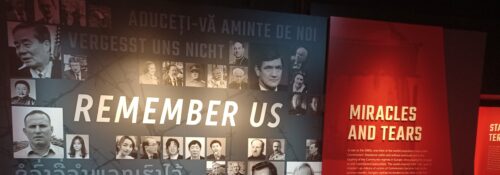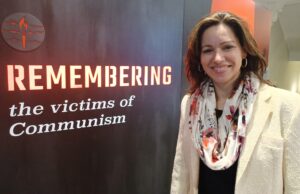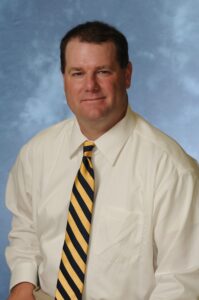
A Project of Passion
Written by Doug Goodnough
 During the height of the COVID-19 pandemic, some people used the time to binge watch Netflix series, reorganize their closets, or tackle a home improvement project.
During the height of the COVID-19 pandemic, some people used the time to binge watch Netflix series, reorganize their closets, or tackle a home improvement project.
However, Dr. Elizabeth Edwards Spalding, ’88, spent most of her time researching, curating, and establishing the new Victims of Communism Museum in Washington, D.C. The approximately $40 million endeavor was dedicated on June 8 and opened to the public on June 13.
“It’s been over 32 years since the idea came up of a memorial and a museum,” said Dr. Spalding, who serves as the museum’s founding director. “To get to where we are now, the particular museum concepts started to be put together three-plus years ago.”
Her passion in educating people about the evils of communism goes back to her childhood days. Her father, noted conservative historian Lee Edwards, co-founded the Victims of Communism Memorial Foundation. The nonprofit organization is behind the creation of both the VOC Museum and the memorial that was dedicated 15 years ago just a few blocks from the museum by then-President George W. Bush.
“I grew up in an anti-communist household,” said Dr. Spalding, who joined the VOC Board four years ago and currently serves as its vice chair. “I was present at the creation of the idea of it (museum and memorial) over 30 years ago.”
With limited resources, the foundation board was hoping to find someone with the background and expertise to serve as founding director. That person was Dr. Spalding. A Senior Fellow at the Pepperdine University School of Public Policy, she was tasked with “pretty much everything” in developing the museum’s themes and content.
And she did it all pro bono.
“The main task at first was working on the actual copy, the written content for the museum,” she said. “I researched and wrote most of what you see on the walls (of the museum). I had fewer than 4,000 words in three permanent galleries to tell the story of all the victims of communism since 1917. I pulled all-nighters for the first time since putting out The Collegian.”
She was also fully engaged in the design and messaging throughout the construction process.
“The content I wanted to get just right. I wanted it to be not only error-free, but also tell the story as compellingly and as movingly as possible,” Dr. Spalding said. “We want all generations to understand and feel the history of the victims of communism as they go through the museum.”
Contracting design firms who were involved in the Holocaust, World War II, and Spy Museums, Dr. Spalding said there was an emphasis on using multimedia and visual displays to show that communist regimes have killed more than 100 million people worldwide and oppressed many hundreds of millions more. Visitors can watch compelling videos chronicling the atrocities that communism inflicted and continues to inflict on numerous countries, or access more detailed information from the various kiosks strategically placed around the galleries.
On the second floor, there is a special visiting exhibit that will rotate a couple of times a year. Currently there is a special exhibit spotlighting the 1989 Tiananmen Square protests and massacre in China. Before exiting the museum, Dr. Spalding said there is a special “Remember Us” wall graphic that is a powerful final reminder of what the VOC Museum represents.
“We would like to one day have something as big as the Holocaust Museum, but we found space that would work really well for what we are calling a ‘jewel box’ museum,” Dr. Spalding said. “We wanted to tell the entire story of all the victims of communism, not just some of the victims.…Our museum is about the past, present, and future.”
A politics major with history and French minors at Hillsdale, Dr. Spalding said she relied on her Hillsdale education during the project.
“It was very helpful for me to have that kind of combination to draw on from Hillsdale,” she said. “I always thought that politics and history have to go together, that they should not be divided or separated.”
Dr. Spalding is also a Visiting Fellow in Hillsdale’s Van Andel Graduate School of Government. Her husband, Dr. Matthew Spalding, serves as dean and also is the vice president of operations at the Kirby Center. Their daughter, Catherine, is entering her junior year at Hillsdale.
Dr. Spalding is not the only Hillsdale connection to the Victims of Communism Memorial Foundation and its museum. Current VOC staff who are Hillsdale alumni include Abraham Armstrong, ’08; Colleen Prince, ’19; and Lily McHale, ‘22. Birch Smith, ’19, is working for VOC on a contract basis, while Julianna Rylko, ’23, is the current summer intern.
Dr. Spalding said she hopes the VOC Museum will become a must-see venue for Washington, D.C., visitors.
“We have more than 1.5 billion people still living under communist regimes,” she said. “A legacy piece is very important—understanding that what’s going on now has roots in the past.”
The Victims of Communism Museum is located at 900 15th Street NW, in Washington, D.C. To learn more, visit www.vocmuseum.org.

Doug Goodnough, ’90, is Hillsdale’s new director of Alumni Marketing. He’s looking forward to connecting with fellow alumni in new and wonderful ways.
Published in July 2022